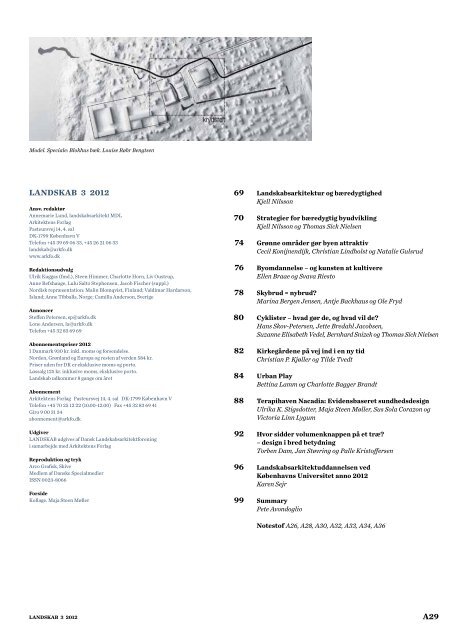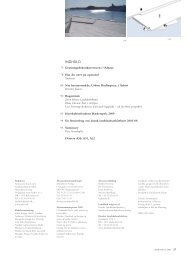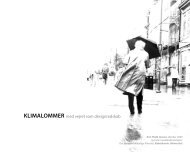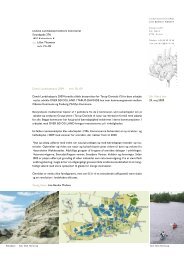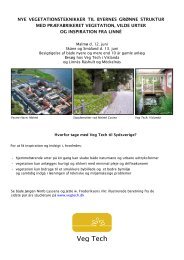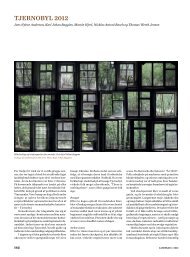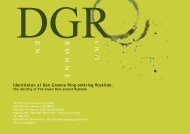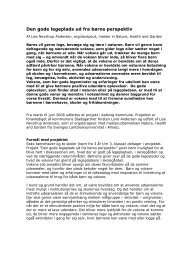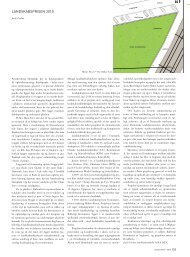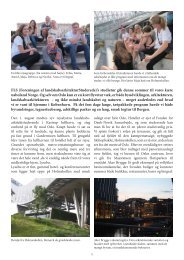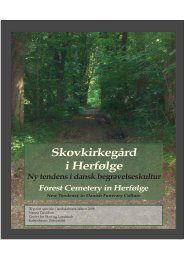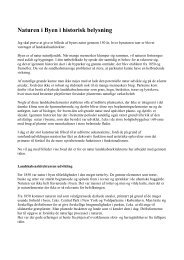landskab 3 2012 - Danske Landskabsarkitekter
landskab 3 2012 - Danske Landskabsarkitekter
landskab 3 2012 - Danske Landskabsarkitekter
You also want an ePaper? Increase the reach of your titles
YUMPU automatically turns print PDFs into web optimized ePapers that Google loves.
Model. Speciale: Blokhus bæk. Louise Røhr Bengtsen<br />
LANDSKAB 3 <strong>2012</strong><br />
Ansv. redaktør<br />
Annemarie Lund, <strong>landskab</strong>sarkitekt MDL<br />
Arkitektens Forlag<br />
Pasteursvej 14, 4. sal<br />
DK-1799 København V<br />
Telefon +45 39 69 06 33, +45 26 21 06 33<br />
<strong>landskab</strong>@arkfo.dk<br />
www.arkfo.dk<br />
Redaktionsudvalg<br />
Ulrik Kuggas (fmd.), Steen Himmer, Charlotte Horn, Liv Oustrup,<br />
Anne Refshauge, Lulu Salto Stephensen, Jacob Fischer (suppl.)<br />
Nordisk repræsentation: Malin Blom qvist, Finland; Valdimar Hardarson,<br />
Island; Anne Tibballs, Norge; Camilla Anderson, Sverige<br />
Annoncer<br />
Steffen Petersen, sp@arkfo.dk<br />
Lone Andersen, la@arkfo.dk<br />
Telefon +45 32 83 69 69<br />
Abonnementspriser <strong>2012</strong><br />
I Danmark 930 kr. inkl. moms og forsendelse.<br />
Norden, Grønland og Europa og resten af verden 584 kr.<br />
Priser uden for DK er eksklusive moms og porto.<br />
Løssalg 125 kr. inklusive moms, eksklusive porto.<br />
Landskab udkommer 8 gange om året<br />
Abonnement<br />
Arkitektens Forlag Pasteursvej 14, 4. sal DK-1799 København V<br />
Telefon +45 70 25 12 22 (10.00-12.00) Fax +45 32 83 69 41<br />
Giro 9 00 31 34<br />
abonnement@arkfo.dk<br />
Udgiver<br />
LANDSKAB udgives af Dansk Landskabsarkitektforening<br />
i samarbejde med Arkitektens Forlag<br />
Reproduktion og tryk<br />
Arco Grafisk, Skive<br />
Medlem af <strong>Danske</strong> Specialmedier<br />
ISSN 0023-8066<br />
Forside<br />
Kollage. Maja Steen Møller<br />
69<br />
Landskabsarkitektur og bæredygtighed<br />
Kjell Nilsson<br />
Strategier for bæredygtig byudvikling<br />
Kjell Nilsson og Thomas Sick Nielsen<br />
Grønne områder gør byen attraktiv<br />
Cecil Konijnendijk, Christian Lindholst og Natalie Gulsrud<br />
Byomdannelse – og kunsten at kultivere<br />
Ellen Braae og Svava Riesto<br />
Skybrud = nybrud?<br />
Marina Bergen Jensen, Antje Backhaus og Ole Fryd<br />
Cyklister – hvad gør de, og hvad vil de?<br />
Hans Skov-Petersen, Jette Bredahl Jacobsen,<br />
Suzanne Elisabeth Vedel, Bernhard Snizek og Thomas Sick Nielsen<br />
Kirkegårdene på vej ind i en ny tid<br />
Christian P. Kjøller og Tilde Tvedt<br />
Urban Play<br />
Bettina Lamm og Charlotte Bagger Brandt<br />
Terapihaven Nacadia: Evidensbaseret sundhedsdesign<br />
Ulrika K. Stigsdotter, Maja Steen Møller, Sus Sola Corazon og<br />
Victoria Linn Lygum<br />
Hvor sidder volumenknappen på et træ?<br />
– design i bred betydning<br />
Torben Dam, Jan Støvring og Palle Kristoffersen<br />
Landskabsarkitektuddannelsen ved<br />
Københavns Universitet anno <strong>2012</strong><br />
Karen Sejr<br />
Summary<br />
Pete Avondoglio<br />
Notestof A26, A28, A30, A32, A33, A34, A36<br />
LANDSKAB 3 <strong>2012</strong> A29<br />
70<br />
74<br />
76<br />
78<br />
80<br />
82<br />
84<br />
88<br />
92<br />
96<br />
99
Landskabsarkitektur og bæredygtighed<br />
Kjell Nilsson<br />
Verdens byer står over for en gigantisk udfordring.<br />
Samtidig med, at de skal være lokomotiv<br />
for økonomisk vækst og social integration,<br />
skal de omstille sig til en bæredygtig udvikling.<br />
Hvis det ikke lykkes, vil mange af verdens<br />
storbyer få enorme problemer med stormfloder,<br />
hedebølger og stigende havniveau – et<br />
scenario hvor en apokalyptisk science fiction<br />
film som Waterworld bliver til hård virkelighed.<br />
Omstillingen til en CO 2 -neutral by er ikke<br />
uproblematisk. Den simple løsning på problemet<br />
hedder fortætning. Den tager udgangspunkt<br />
i australieren Peter Newmans sammenligning<br />
af energiforbruget til transport<br />
i europæiske, asiatiske og nordamerikanske<br />
byer. Men den kompakte by er også en sårbar<br />
by. Der findes ingen grønne områder, der<br />
kan optage regnvandet, eller træer, som giver<br />
læ ved stormvejr og skygge i forbindelse med<br />
hedebølger.<br />
Det er det, man på engelsk beskriver som<br />
”the conflict between mitigation and adaptation<br />
to climate change”. Derfor skal fremtidens<br />
by være tæt og grøn – den tætte haveby.<br />
Der er ikke nogen, som siger, at en grøn by<br />
nødvendigvis skal sprede sig ud over <strong>landskab</strong>et.<br />
Ifølge beregninger, som Peter Hall præsenterer<br />
i bogen City of Tomorrow, skulle Ebenezer<br />
Howards utopiske haveby være lige så<br />
tæt som det centrale London er i dag.<br />
At omsætte visionen om en bæredygtig,<br />
grøn og tæt by til virkelighed kræver nye stra-<br />
tegier og nye kompetencer. Vi har brug for by-<br />
planlæggere, som kan kombinere arkitektens<br />
visioner og designevner med naturvidenskabernes<br />
analyse og viden om de biologiske<br />
forudsætninger for liv og miljø. Det er grunden<br />
til, at Skov & Landskab for fem år siden<br />
besluttede sig for et meroptag på <strong>landskab</strong>sarkitektuddannelsen<br />
af studerende via fagpakken<br />
i bydesign.<br />
Så har vi spørgsmålet om for og imod<br />
masterplaner. Stig L. Andersson introduce-<br />
rer i LANDSKAB 1-<strong>2012</strong> begrebet procesurbanisme,<br />
hvor ”kontrol og styring bliver droppet”,<br />
og hvor det er naturens processer, som er<br />
forbilledet, ”når vi designer vores byer”. Vores<br />
studier af europæiske byregioner (se artikel<br />
på s. 70) viser samtidig, at der er behov for en<br />
stærk overordnet planlægning. Men vi bliver<br />
også nødt til at acceptere, at udviklingen går i<br />
den modsatte retning.<br />
For mig at se er der tale om, vist nok, meget<br />
forskellige strategier, men med et fælles<br />
mål – bæredygtig byudvikling. Den planlægningssituation,<br />
som for eksempel fødte fingerplanen,<br />
eksisterer ikke længere. I gamle dage<br />
udstykkede man store arealer til et bestemt<br />
formål, og så bebyggede man dem ifølge planen.<br />
I dag er udviklingen meget mere kompleks.<br />
Når planen endelig er gennemført,<br />
er den som regel forældet. Se for eksempel<br />
på udviklingen i de erhvervsområder, som<br />
engang blev udstykket til industri , men som<br />
efterfølgende er erstattet med helt andre<br />
andre typer af virksomheder.<br />
Jeg tror stadigvæk på, at restriktiv planlovgivning<br />
er et vigtigt instrument, men det er<br />
ikke nok. Vi har også brug for en mere offensiv<br />
strategi for at spille en mere aktiv rolle fremtidens<br />
byudvikling. Stig L. Andersson er en af de<br />
<strong>landskab</strong>sarkitekter, som har udviklet faget i<br />
en sådan retning. Det er en af grunderne til, at<br />
et enigt bedømmelsesudvalg bestående af professor<br />
emeritus Thomas Sieverts, Darmstadt;<br />
professor Jan Søndergaard, Kunstakademiets<br />
Arkitektskole; professor Tiina Sarap, dekan<br />
ved Sveriges Lantbruksuniversitet, Alnarp;<br />
samt fra Københavns Universitet, professorerne<br />
Ellen Braae og Jørgen Primdahl, har<br />
bedømt ham som kvalificeret til et professorat<br />
i <strong>landskab</strong>sarkitektur med særlig fokus på<br />
urban design.<br />
Kontakten med erhvervet er central for<br />
Skov & Landskab. Vi sætter meget stor pris<br />
på den værdifulde indsats, som mange kollegaer<br />
yder som undervisningsassistenter og<br />
som medlemmer af rådgivende udvalg. Vi glæder<br />
os også til at se <strong>landskab</strong>sarkitekt Torben<br />
Schønherr som nyt medlem af Skov & Landskabs<br />
bestyrelse.<br />
Endvidere er DL’s formand Jacob Kamp<br />
medlem af aftagerpanelet for Skov & Landskabs<br />
uddannelser. Han har i den sammenhæng<br />
udtalt en frygt for, at ”det rumligt forslagsstillende<br />
forsvinder ud af uddannelsen,<br />
til fordel for en mere teoretisk forskningsbaseret<br />
tilgang”. Det rumligt forslagsstillende<br />
må aldrig forsvinde ud af <strong>landskab</strong>sarkitektuddannelsen,<br />
men som akademisk uddannelse<br />
skal den også være forskningsbaseret.<br />
Det er et krav, som vi hverken må eller vil give<br />
slip på.<br />
Hvordan ser fremtiden ud? Den 1. januar<br />
<strong>2012</strong> fusionerede det Biovidenskabelige<br />
Fakultet (LIFE, dvs. den tidligere Landbohøjskole)<br />
med det Naturvidenskabelige Fakultet<br />
(NAT) til et nyt fakultet (SCIENCE). Som en<br />
del af fusionen bliver Skov & Landskab lagt<br />
sammen med Institut for Geologi og Geografi<br />
til et nyt institut for geovidenskab, naturressourcer<br />
og planlægning. Det er ikke en sammenlægning,<br />
vi selv har valgt, men en sammenlægning<br />
som vi går positivt ind i og vil<br />
arbejde for at få det bedst mulige ud af.<br />
Det betyder blandt andet, at <strong>landskab</strong>sarkitekt-<br />
og geografiuddannelserne kommer<br />
under det samme institut. Det er i dag to<br />
stærke uddannelser, hver især med tydelige<br />
profiler, som alle ønsker at bevare. Fordelen<br />
ved fusionen er, at det giver vores studerende<br />
større valgmuligheder, samtidig med at vi i det<br />
‘gamle’ Skov & Landskab kan udvikle det, som<br />
vi er bedst til, nemlig at forske og undervise i<br />
planteanvendelse, <strong>landskab</strong>steknologi, parkforvaltning,<br />
<strong>landskab</strong>sarkitektur og bydesign.<br />
Kjell Nilsson, <strong>landskab</strong>sarkitekt mdl,<br />
forskningschef og leder af Afdeling for Parker<br />
og Urbane Landskaber, Skov & Landskab,<br />
Københavns Universitet<br />
LANDSKAB 3 <strong>2012</strong> 69
summary<br />
Landscape architecture and sustainability,<br />
p. 69<br />
Kjell Nilsson<br />
The realization of a vision of a sustainable,<br />
green and dense city requires new strategies<br />
and new competencies. We need city planners<br />
who can combine the architect’s visions<br />
and design abilities with the natural sciences’<br />
analyses and knowledge of the biological basis<br />
for life and the environment. This is the reason<br />
that five years ago Skov & Landskab decided<br />
to increase the number of students accepted<br />
to the landscape architecture education via<br />
a subject program in urban design.<br />
The contact with the profession is a central<br />
element at Skov & Landskab. We place<br />
great emphasis on the worthwhile efforts that<br />
many of our colleagues offer as teaching assistants<br />
and as members of advisory committees.<br />
How does the future look? On January 1,<br />
<strong>2012</strong> the Bioscience Faculty (LIFE, i.e., the<br />
former Agricultural College) merged with<br />
the Faculty of Natural Sciences (NAT) to create<br />
a new faculty (SCIENCE). As part of this<br />
merger, Skov & Landskab was combined with<br />
the Institute for Geology and Geography to<br />
create a new institute for geoscience, natural<br />
resources and planning.<br />
This means that studies such as landscape<br />
architecture and geography are now part of<br />
the same institute. Today there are two strong<br />
educations, each with its own profile, which<br />
everyone wants to preserve. The advantage<br />
of the fusion is that it gives our students a<br />
broader opportunity of choice, while we at the<br />
‘old’ Skov & Landskab can develop that, which<br />
we are best at, namely research and teaching<br />
in plant usage, landscape technology, park<br />
administration, landscape architecture and<br />
urban design.<br />
Strategies for sustainable urban<br />
development, p. 70<br />
Kjell Nilsson<br />
The English researcher Michael Batty maintains<br />
in an article in the magazine Science,<br />
that cities grow primarily from bottom up,<br />
and that market forces and transport are key<br />
factors, while physical planing and legislation<br />
play a secondary role. By comparing the situation<br />
at different places in Europe we can prove<br />
that sustainable urban development implies<br />
strong planing and control on a regional level.<br />
At the same time we must also ascertain that<br />
the trend is moving in the opposite direction<br />
toward more laissez-faire policies and decentralization.<br />
PLUREL (Peri-urban Land Use RELationships)<br />
is a so-called integrated project under<br />
EU’s 6. Framework program. It was carried<br />
out between 2007-11. The total budget was 11<br />
million Euros. 35 partners from 14 European<br />
countries as well as China participated in the<br />
project that was coordinated by Skov & Landskab<br />
at Copenhagen University.<br />
www.plurel.net<br />
Green areas make the city attractive, p. 94<br />
Cecil Konijnendijk, Christian Lindholst and<br />
Natalie Gulsrud<br />
A multidisciplinary project the Nordic Green<br />
Space Award aims at creating a new quality<br />
mark for parks and green areas in Scandinavia.<br />
The vision is to encourage, market and develop<br />
green areas’ experience and recreational<br />
values in the Nordic countries.<br />
The project involves more than 25 partners<br />
consisting of municipalities, interest<br />
groups, user representatives and research<br />
institutions in Norway, Sweden and Denmark.<br />
Internationally, the final ‘quality mark’<br />
will contribute to branding the Nordic countries<br />
and the participating cities via a network<br />
of green areas. Nationally and locally,<br />
the arrangement will contribute to increasing<br />
the awareness of the users and politicians to<br />
the value of green areas and this honor should<br />
become part of the coming branding strategies.<br />
The project will be completed in <strong>2012</strong>.<br />
www.greenspaceaward.com<br />
Urban conversion – and the art of<br />
cultivation, p. 76<br />
Ellen Braae and Svava Riesto<br />
The city is a living organism in a state of constant<br />
change, and urban conversions can be<br />
considered to be cultivation. Cultivare has<br />
Latin origins and means to ‘cultivate growth.’<br />
Together with the concept of creating space,<br />
the cultivating landscape architecture’s primary<br />
task is to cultivate everything from<br />
plants to urban spaces, housing areas, roads<br />
and interspaces – in short, the urban landscape.<br />
This implies a special attention to how<br />
these kinds of conversions can occur, and<br />
together with a mapping of the values, strategies<br />
and design approaches, which are at play<br />
in current planning, represent a central point<br />
for the research group for Landscape architecture<br />
and urbanism.<br />
Cloudburst = new departure?, p. 78<br />
Marina Bergen Jensen, Antje Backhaus and<br />
Ole Fryd<br />
On July 2, 2011, 135 mm of rain fell over Copenhagen.<br />
Streets and lanes were flooded.<br />
Basements were under water. In all there<br />
were damages for 4-5 billion kroner. Some<br />
required here and now investments in heavy<br />
infrastructure, and the notion of Copenhagen<br />
with a canal system a la Amsterdam arose.<br />
Most people agreed that there was a need for<br />
action.<br />
We would like to suggest a bit of levelheadedness<br />
in this case. We have a unique window<br />
of opportunity that we can use to create better,<br />
more climate-friendly cities and at the<br />
same time generate social added-value. If we<br />
are to invest in grand cloudburst measures, we<br />
should carefully consider our actions and try<br />
to get as much synergy as possible out of these<br />
investments. This requires time for thoughtfulness<br />
and new thinking. Landscape architects,<br />
together with other relevant professions<br />
have a social responsibility to develop and<br />
present good, integrated solutions that can<br />
serve as alternatives to conventional sewer<br />
and canal solutions and at the same time gain<br />
the unique opportunities for urban renewal<br />
and product development.<br />
Cyclists – What do they do, and what do they<br />
want?, p. 80<br />
Hans Skov-Petersen, Jette Bredahl Jacobsen,<br />
Suzanne Elisabeth Vedel, Bernhard Snizek<br />
and Thomas Sick Nielsen<br />
The bikeability project is financed by The<br />
Strategic Research Council. It runs from 2010<br />
to 2014 with a total budget of ca. 17 million kr.<br />
The purpose of the project is to investigate:<br />
A. Danish municipalities’ efforts in terms<br />
of bicycle planning, including any experience<br />
gained over time with different measures,<br />
B. The correlation between different urban<br />
structures and geographic relationship’s<br />
influence on the amount of cycling and physical<br />
activity, and C. How bicyclists move about<br />
in and experience urban spaces.<br />
The project is being carried out by a number<br />
of universities and organizations.<br />
www.bikeability.dk and www.cykelviden.dk<br />
Cemeteries facing new times, p. 82<br />
Christian P. Kjøller and Tilde Tvedt<br />
There is an increasing focus on cemeteries.<br />
The PhD project: Cemetery – administration,<br />
care and implementation of quality descriptions<br />
will be completed in fall <strong>2012</strong>, and it further<br />
strengthens Skov & Landskab’s competence<br />
in the area of cemeteries.<br />
It has also given the opportunity of letting<br />
landscape architecture students work with<br />
cemeteries in the course Plants and technology.<br />
In addition we are working on tailoring<br />
part of Skov & Landskab’s general knowledge<br />
of operation and planting technology for cemeteries<br />
via the Knowledge service for Park and<br />
Landscape.<br />
LANDSKAB 3 <strong>2012</strong> 99
summary<br />
Urban Play, p. 84<br />
Bettina Lamm and Charlotte Bagger Brandt<br />
With our multidisciplinary approach we share<br />
a vision that through architectural and artistic<br />
strategies we can create new settings for play,<br />
life and engagement in public spaces. In our<br />
approach to the project Urban Play we don’t<br />
differentiate between the common professional<br />
boundaries; artist, curator, architect<br />
and city planner. In this way we participate as<br />
creative players in the project. We create and<br />
map the playing board, so to speak, its rules<br />
and its visualization with our respective experiences<br />
as landscape architect and curator/art<br />
historian and we invite a mixed bag of artists,<br />
architects and urban space activists to participate<br />
in this urban game.<br />
www.urbanplay.dk<br />
Therapy garden Nacadia: Evidence-based<br />
health design, p. 88<br />
Ulrika K. Stigsdotter, Maja Steen Møller,<br />
Sus Sola Corazon and Victoria Linn Lygum<br />
At the therapy garden Nacadia a so-called<br />
mindfulness-inspired garden therapy is employed<br />
where the garden is used as a therapeutical<br />
tool, so that the patients’ experiences,<br />
sense impressions, activities and relations to<br />
the nature environment are a significant part<br />
of the therapeutical process. But in addition<br />
to being a treatment place, Nacadia will also<br />
serve as a research, development and demonstration<br />
project in the area of ‘evidence-based<br />
health design’ and stress therapy. An important<br />
aspect in Skov & Landskab’s interpretation<br />
of evidence-based health design is that<br />
the process does not stop when the garden is<br />
completed. The therapy garden is considered<br />
as a process in itself, where new research and<br />
documented experience will continuously add<br />
new and strong evidence to the design so that<br />
Nacadia can constantly develop.<br />
Where is the volume knob on a tree? – design<br />
in a broad sense, p. 92<br />
Torben Dam, Jan Støvring and Palle Kristoffersen<br />
Design – in the word’s broad sense – is perhaps<br />
the phrase that is most descriptive when<br />
a planting proposal is created on the drawing<br />
board. But plants should grow and develop in<br />
an interplay with other plants, soil conditions<br />
and the urban space. In this course, plants and<br />
technology at the landscape architect education<br />
at Copenhagen University are instrumental<br />
in getting the students to formulate<br />
architectural goals for their planting proposals<br />
before they decide the individual plant<br />
species. The goal is a sustainable, structured<br />
planting.<br />
The landscape architecture education at<br />
Copenhagen University anno <strong>2012</strong>, p. 96<br />
Karen Sejr<br />
Landscape architecture and city planning at<br />
Copenhagen University combine creativity<br />
and aesthetics with biological knowledge. It is<br />
a practice-oriented education with a focus on<br />
plants, design, nature, urban life and a good<br />
study environment.<br />
On September 1, 2011, 75 new students<br />
started their bachelor’s education in landscape<br />
architecture at Copenhagen University.<br />
During the entire first study year, the<br />
students participate in the course Plan and<br />
Design. Here the focus is placed on landscape<br />
architecture’s means, space, scale, color, etc.<br />
and the tools that landscape architects use,<br />
plan, section, model and spatial visualizations.<br />
Through lectures and excursions, the<br />
students are made aware of the profession’s<br />
wide variety of works. They also gain knowledge<br />
of the broad extent of the landscape<br />
architectural language: avenues and axes, the<br />
gardens of the baroque and romanticist periods<br />
and elements such as point de vue and<br />
trompe-l'oeil.<br />
At the moment there is no special course<br />
in Landscape architecture history, but Richard<br />
Hare, who is head of the bachelor program,<br />
has given this a high priority and it is much<br />
desired on the list of courses that should be<br />
offered to landscape architecture students.<br />
The study of landscape architectural<br />
craftsmanship is supplemented by natural<br />
science courses that deal with soil, water,<br />
vegetation and ecology. And finally the different<br />
courses are linked together through<br />
project work, such as when the first year students<br />
design rainwater beds on a parking lot<br />
in northwest Copenhagen. Proposals that<br />
not only have an architectural basis but also<br />
a planting content.<br />
According to Richard Hare this is also<br />
one of the areas where the education will be<br />
improved: “For the first time this year we have<br />
been able to couple teaching in botany and the<br />
use of plants together with the course Plan<br />
and Design. This implies that already from the<br />
first year of study, we discuss the use of different<br />
plants and employ them in the design.<br />
I would like to further develop this and contribute<br />
to ensuring that the study of the use of<br />
plants becomes part of the bachelor program<br />
in the landscape architecture education as a<br />
new independent course in the use of plants.”<br />
In the second year of study, the education<br />
is divided in an Urban design package and a<br />
Landscape design package. The former deals<br />
with urban planning, the city’s structure and<br />
dynamics, and the latter focuses on plants and<br />
gardens. A common element in the two study<br />
packages is the profession’s scientific theory<br />
as well as a number of elective courses.<br />
During the third year of study, there is a<br />
bachelor internship after Christmas. These<br />
internships are at green administration<br />
offices in the Danish municipalities or at private<br />
offices, both large and small. And finally<br />
the landscape architect students in the bachelor<br />
program in recent years have used the<br />
opportunity to work abroad. This includes<br />
cities like Seattle and New York City in USA,<br />
and in Holland, Germany and France.<br />
The master’s program is run in English<br />
and offers three different specialized programs:<br />
Landscape Planning, Urban Design and<br />
Green Space Management.<br />
The goal of the Landscape Planning program<br />
is to strengthen the students’ competencies<br />
in design, both on a theoretical and<br />
practical level. This specialization is based on<br />
two obligatory courses: Theory and Method in<br />
Landscape Architecture and Landscape Planning.<br />
In addition to this there are a number of<br />
elective courses and finally the degree projects,<br />
which in most cases last a half year. This<br />
applies to all three specializations.<br />
Urban Design combines the development<br />
of strategies with design-interventions and<br />
provides a foundation in ecological urbanism.<br />
This program is base on the courses Theories<br />
of Urban Design, Urban Ecosystems and The<br />
Urbanism Studio.<br />
Green Space Management focuses on the<br />
socio-political and organizational aspects<br />
of the administration and planning of green<br />
areas. The basis for this program is the<br />
courses Urban Forestry & Urban Greening<br />
and the new course Design by management,<br />
which is based on the fact that the design of<br />
our green spaces is to a great degree the result<br />
of care and cultivation.<br />
A few years ago, the master’s program in<br />
landscape architecture was converted to an<br />
international, English language education.<br />
This has been a challenge, but in most cases<br />
a great advantage for the program. It attracts<br />
many talented foreign students who use the<br />
opportunity to learn about the Nordic tradition<br />
and about Danish landscape architecture,<br />
and who contribute to heightening the level<br />
among the Danish master students.<br />
The cosmopolitan environment provides<br />
the Danish students with an international net-<br />
work, the ability to communicate landscape<br />
architecture theory in English and the courage<br />
to study abroad – and give future landscape<br />
architects the ability to work abroad.<br />
www.sl.life.ku.dk<br />
Pete Avondoglio<br />
100 LANDSKAB 3 <strong>2012</strong>


